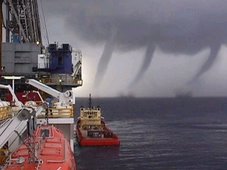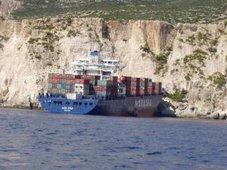So, I am going to start a series of discussions, post articles and reports on subsea atmospheres and introduce you to a different type of storm chaser, "Oceanographers".
As I have stated before, we have a tendency to view things on a one plane thought process, namely, we process things as we "see" them. Much of what happens throughout the weather story we still do not see directly, yet. Moreover, science has been studying subsea or underwater atmospheres or storms, also known as, "Benthic Storms" for some time now. Maybe one day we will have ocean study as a national priority.
Much of our weather I believe, actually is generated by weather patterns not just by surface atmospheres, but also by weather patterns created by subsea attmospheres and environments. Basically, the ocean has its own weather system, with winds and underwater storms that we never hear about or even see. . Oceanographer Dave Gallo from the Woods Hole Oceanographic Institute describes how much more there is going on in the ocean than we think.
According to Gallo, "70 % of the planet, 95% of the biosphere, there are the highest mountains, the deepest valleys, the largest waterfall. There are more animals in the sea than on earth. 99% of the heat on the planet that comes from the sun is stored in the top few tens of feet of the ocean. It has everything the atmosphere has and more, it has everything that the land has and more and yet it's hardly explored, we've really seen less than 1% of what's out there.
Something oceanographers didn't expect were underwater storms. During a recent research mission to the deepest and darkest part of the ocean where things were thought to be quite stable - patterns from sediment samples showed disruptions as if a storm had ripped through.
There's a large mass of either sediments and/or water moving usually with gravity downhill or moving with currents across the sea floor. They can be fairly vicious.
An underwater storm can also cause damage on land, although indirectly. Back in the early 1900's a storm ripped across the sea floor and snapped northeastern transatlantic cables. The ocean has weather very similar to the atmosphere with high and low-pressure systems, clear days, and cloudy days:
The same kinds of things we see on the weather channel we see in the ocean and yet these things operate apart from the atmosphere.
Just like predicting the weather on land, underwater predicting is difficult as well. It's still an unfamiliar world."
Understanding subsea environments and being able to forecast subsea storms, as we do surface storms today, may not just answer many questions we do not understand about our oceans, but answer the question, where do freak or rogue waves come from? Hopefully benefiting mariners with advanced warning of dangerous SWH's or waves and more importantly save lives, cargo and ships.
Lets start with the basics, the physical and chemical make up of the oceans, with a paper titled, The Blue Planet,.
Weather Note;
Typhoon MAN-YI late yesterday became a Super Typhoon or a CAT-5 Hurricane as it struck the "Rock" and is tracking for Japan.
"The eye of Man-Yi was 189 kilometers from the city of Naha on the main island of Okinawa at 5 p.m. Japanese time today, the Japan Meteorological Agency said on its Web site. The storm is moving north across open water at 30 kilometers per hour after crossing Okinawa prefecture, which has a population of 1.4 million people.
The meteorological office said Man-Yi is ``extremely strong'' and issued warnings of gales, heavy rain, high waves and a tidal surge throughout Okinawa, the location of the biggest American airbase outside the U.S., and parts of Kyushu island to the north. National broadcaster NHK said areas of Miyazaki prefecture in Kyushu were flooded, and showed images of cars blown over and downed power lines. Bloomberg News."
Chicago weekend weather? Breath taking!
Have a really great weekend!
RS


































































































![Validate my RSS feed [Valid RSS]](valid-rss.png)